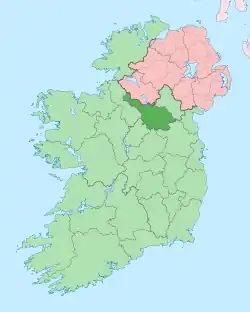Drumcullion
Drumcullion (Irish derived place name, Droim Cuilinn, meaning 'The Ridge of the Holly') is a townland in the civil parish of Kinawley, barony of Tullyhaw, County Cavan, Ireland.[1]
Geography
Drumcullion is bounded on the north by Drumboory townland, on the west by Derryrealt and Gubrawully townlands and on the east by Drumcar (Kinawley) townland. Its chief geographical features are the hill which the townland is named after, reaching a height of 335 feet, mountain streams, forestry plantations, a spring well and dug wells. Drumcullion is traversed by minor public roads and rural lanes. The townland covers 86 statute acres.[2]
History
In medieval times Drumcullion was owned by the McGovern clan and formed part of a ballybetagh spelled (variously) Aghycloony, Aghcloone, Nacloone, Naclone and Noclone (Irish derived place name Áth Chluain, meaning ‘The Ford of the Meadow’). The 1609 Baronial Map depicts the ballybetagh as Naclone.[3]
In the Plantation of Ulster by grant dated 26 June 1615, King James VI and I granted, inter alia, The precinct or parcel of Nacloone otherwise Aghcloone to Sir George Graeme and Sir Richard Graeme to form part of the Manor of Greame.[4] A history of Richard and George Graham is viewable online.[5] The Grahams took part in the Irish Rebellion of 1641 and after the war their lands were confiscated under the Act for the Settlement of Ireland 1652.
The 1821 Census of Ireland spells the name as Drumcullen and states- containing 47 acres of arable land & 5 thereof bog.[6] The Tithe Applotment Books 1834 spell the name as Drumcullin.[7] Griffith's Valuation of 1857 lists eight landholders in the townland.[8]
The landlord of Drumcullion in the 19th century was the Hassard Estate.[9]
Folklore about Drumcullion is in the 1938 Dúchas collection.[10]
Census
| Year | Population | Males | Females | Total Houses | Uninhabited |
|---|---|---|---|---|---|
| 1841 | 46 | 23 | 23 | 7 | 0 |
| 1851 | 53 | 24 | 29 | 8 | 0 |
| 1861 | 51 | 26 | 25 | 7 | 0 |
| 1871 | 21 | 11 | 10 | 6 | 0 |
| 1881 | 28 | 17 | 11 | 6 | 0 |
| 1891 | 21 | 15 | 6 | 6 | 1 |
In the 1821 census of Ireland there were eight families listed in the townland.[11][12]
In the 1901 census of Ireland, there were seven families listed in the townland.[13]
In the 1911 census of Ireland, there were four families listed in the townland.[14]
Antiquities
- A foot-bridge over the river
References
- "Placenames Database of Ireland". Retrieved 29 February 2012.
- "IreAtlas". Retrieved 29 February 2012.
- The National Archives (30 September 2009). "Map of Tullyhaw, County Cavan (MPF 1/58) – Example of an early Irish map from State Papers c. 1558 – c. 1610" (PDF). Retrieved 9 June 2019.
- Chancery, Ireland (1800). Calendar of the Patent Rolls of the Chancery of Ireland. - (Dublin 1800.) (angl.) 372 S. p. 310. Retrieved 9 June 2019.
- Lloyd D. Graham (31 July 2020). "House GRAHAM: From the Antonine Wall to the Temple of Hymen". pp. 140–153. Retrieved 15 August 2020.
- "004625688/004625688_00050.pdf" (PDF). 4 July 2012. Retrieved 25 May 2019.
- "Griffith's Valuation". askaboutireland.ie. Retrieved 25 May 2019.
- "National Archives: Census of Ireland 1901". census.nationalarchives.ie. Retrieved 25 May 2019.
- "National Archives: Census of Ireland 1911". census.nationalarchives.ie. Retrieved 25 May 2019.
